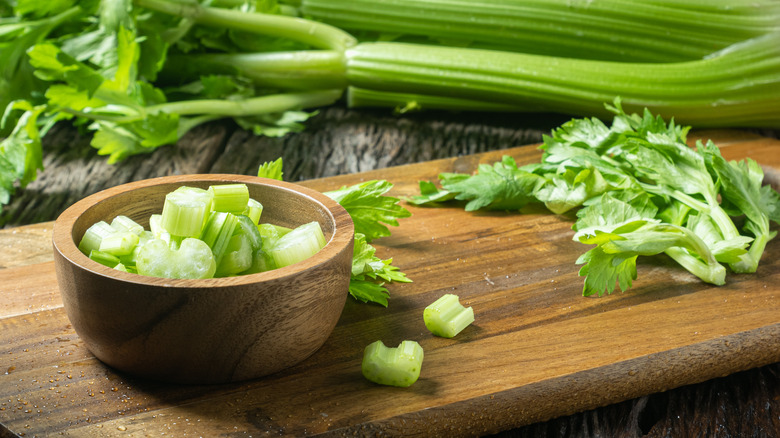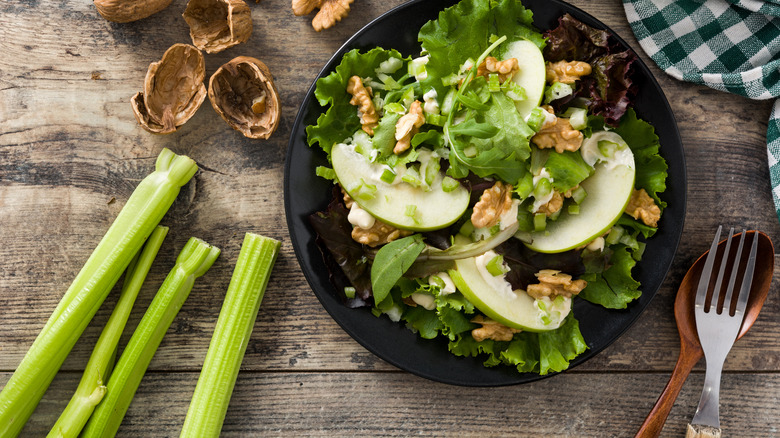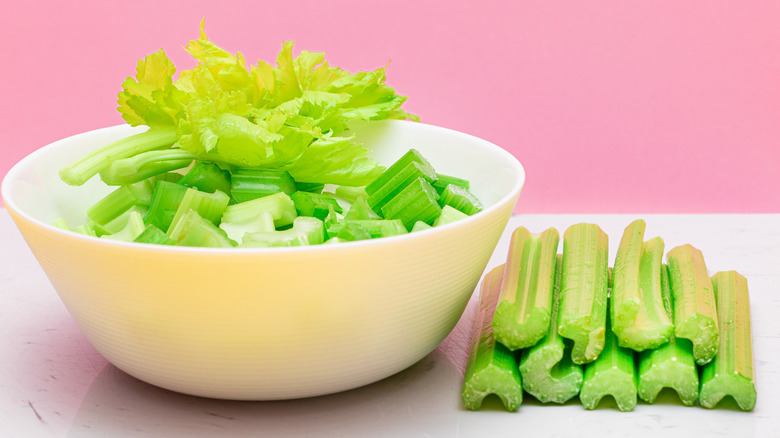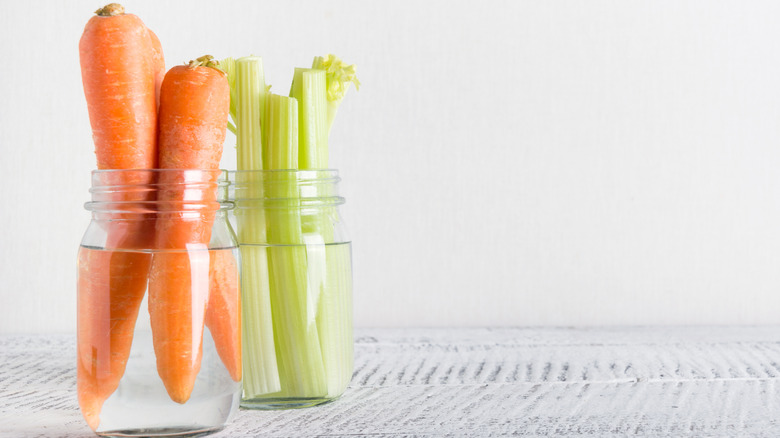The Simple Hack That Will Change The Way You Cut Celery Forever
Whether you're whipping up a tuna salad, putting together a crudité platter, or crafting your go-to stuffing recipe, celery is a staple in many kitchens, as it adds a unique herbaceous flavor and a whole lot of crunch. However, for many individuals, there's one issue preventing them from loving this particular vegetable — the stringy texture of celery's exterior.
In a Reddit thread from seven years ago, one user made the simple suggestion of removing the exterior strings before eating and the post racked up 361 comments. While some Reddit users incredulously commented about what a silly extra step it was, and one even cheekily suggested the best way to enjoy celery was to remove the strings from the stalk and then promptly throw both portions into the compost, there were many individuals who shared their own hatred for the stringy exterior, praising the tips on how to remove those portions. A few users even referred to the tips, shared to the LifeProTips subreddit, as life-changing.
As Taste of Home explains, raw celery has what are called collenchyma cells on the exterior, which are responsible for helping give the produce its customary crunch. These water-filled cells are also the reason behind that stringy texture, though. Yet, while it adds an extra step to your prep process, there's an expert-approved hack to get rid of that stringy exterior in order to whip up the celery dish of your dreams.
How to de-string your celery
While chef and cookbook author Carla Lalli Music unapologetically declared she enjoyed celery in a YouTube video showing how to craft a unique celery caesar salad, she did share a tip with EatingWell for how she removes those stringy outer bits that many find unappealing. And it involves something that you very likely have in your kitchen already — a vegetable peeler.
While you might not consider celery to be vegetable with a peel, Music suggests the easiest way to get rid of those strings (particularly on the outer stalks, which tend to be a bit tougher) is to simply peel the exterior. This effectively removes those stringy portions and you're left with crunchy, string-free celery to enjoy in whatever dish you're making. Or, as Plate in 28 suggests, you could use a sharp paring knife to peel away that exterior portion of your celery.
If the peeling process sounds too tedious, though, several Reddit users suggested another method: Grab the base of the celery stalk you're looking to de-string, snap it, and you should be able to simply pull the thick threads away from the stalk. Finally, if you're unwilling to add an extra step to your celery prep, take Alex Guarnaschelli's tip and go for just those tender inner ribs, per SheKnows. They may still be too stringy for true celery haters, but they are much different in texture and flavor than the exterior stalks.
How to reduce the bitterness
In addition to the unappealing texture of the stringy portions, another key factor that causes celery-haters to avoid the vegetable is its bitterness, as a Reddit thread outlined. Luckily, there are a few ways to help temper that, depending on how you need to use the celery in your dish, starting from the point of purchase.
While you may normally gravitate toward the most vibrant, colorful produce possible, as that's typically a visual indicator of ripeness, you want to go in the opposite direction for celery. As Thrive Cuisine outlines, deeper green stalks are an indicator that the celery will be on the bitter side. This is because they haven't been blanched in the sunlight, a step that helps to combat processes that encourage that color and consequent bitterness to develop, per Gardener's Path. As a last resort, if you just need a small amount, try to exclusively use those tender inner stalks.
If you're trying to rescue celery you've already purchased, there are a few things to consider. You're in luck if your dish requires the celery to be cooked because this will help reduce those bitter flavor notes while highlighting some of the more aromatic, pleasant flavor notes within celery, as Leaf TV reports.
With any preparation, you can also incorporate seasonings designed to counteract bitterness. As Splendid Table suggests, salty and fatty flavors can counteract the bitterness, so you may consider pairing your celery with some strategic flavors.
How to revive your limp celery
If, like Carla Lalli Music, you're a celery lover unbothered by its stringiness or bitterness, there is one hurdle that you may face: reaching into your refrigerator to pull out celery only to find that it's become limp seemingly overnight. Don't immediately toss it out, though — it can typically be revived.
As Cook's Illustrated outlines, an easy way to bring limp celery back to life is to cut off a small portion at the stalks in order to expose more of the interior, and then stand the celery in a jar or container with cold water for an hour or so. MyRecipes explains that this tip works because the cells in those submerged celery stalks will absorb the cold water, firming up the stalks again.
To avoid having to rely on this trick, you may want to change the way you store the vegetable if you love to have crisp celery on hand at all times. Wrapping the celery loosely in aluminum foil, per Cook's Illustrated, will help keep it from becoming dry and limp. Alternatively, you can cut the stalks into smaller pieces and store those in water from the moment you bring the produce home.
Of course, if your celery is limp, it just means you don't want to use it in dishes where you need that crunchy texture. Instead, consider incorporating it in something like a soup or stir-fry, where it'll soften during the cooking process anyway.



